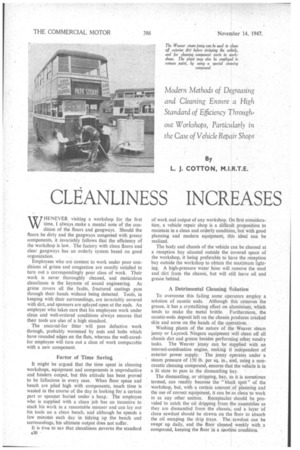CLEANLINESS INCREASES
Page 32

Page 33

If you've noticed an error in this article please click here to report it so we can fix it.
WHENEVER visiting a workshop for the first time, I always make a mental note of the condition of the floors and gangways. Should the floors be dirty and the gangways congested with greasy components, it invariably follows that the efficiency of the workshop is low. The factory with clean floors and clear gangways has an orderly system based on good organization.
Employees who are content to work under poor conditions of grime and congestion are usually satisfied to turn out a correspondingly poor class of work. Their work is never thoroughly cleaned, and meticulous cleanliness is the keynote of sound engineering. As grime covers all the faults, fractured castings pass through their hands without being detected. Tools, in keeping with their surroundings, are invariably covered with dirt, and spanners are splayed open at the ends. An employer who takes care that his employees work under clean and well-ordered conditions always ensures that their tools are also of a high standard.
The uncared-for fitter will pass defective work through, probably worsened by nuts and bolts which have rounded edges on the flats, whereas the well-caredfor employee will turn out a class of work comparable with a new component.
Factor of Time Saving
It might be argued that the time spent in cleaning workshops, equipment and components is unproductive and hinders output, but this attitude has been proved to be fallacious in every case. When floor space and bench are piled high with components, much time is wasted in the course of the day in looking for a certain part or spanner buried under a heap. The employee who is supplied with a clean job has an incentive to stack his work in a reasonable manner and can lay out his tools on a clean bench, and although he spends a few minute's each day in tidying up the bench and surroundings, his ultimate otitput does not suffer.
It is true to say that cleanliness governs the standard A30 of work and output of any workshop. On first consideration, a vehicle repair shop is a difficult proposition to maintain in a clean and orderly condition, but with good planning and modern equipment, this ideal can be realized.
The body and chassis of the vehicle can be cleaned at a reception bay situated outside the covered space of the workshop, it being preferable to have the reception bay outside the workshop to obtain the maximum lighting. A high-pressure water hose will remove the mud and dirt from the chassis, but will still leave oil and grease behind.
A Detrimental Cleaning Solution
To overcome this failing some operators employ a solution of caustic soda. Although this removes the grease, it has a crystallizing effect on aluminium, which tends to make the metal brittle. Furthermore, the caustic-soda deposit left on the chassis produces cracked skin and sores on the hands of the operatives.
Washing plants of the nature of the Weaver steam jenny or Laycock Niagara equipment will clean off all chassis dirt and grease besides performing other sundry tasks. The Weaver jenny can be supplied with an internal-combustion engine, making it independent of exterior power supply. The jenny operates under a steam pressure of 150 lb. per sq. in., and, using a noncaustic cleaning compound, ensures that the vehicle is in a fit state to pass to the dismantling bay.
The dismantling, or stripping, bay, as it is sometimes termed, can readily become the "black spot" of the workshop, but, with a certain amount of planning and the use of correct equipment, it can be as clean to work in as any other section. Receptacles should be provided to catch the oil dripping from the assemblies as they are dismantled from the chassis, and a layer of clean sawdust should be strewn on the floor to absorb the oil escaping the drip trays. The sawdust can be swept ' up daily, and the floor cleaned weekly with, a compound, keeping the floor in a spotless condition. Having removed the assembly from the chassis, the next point to decide is whether to strip it as it is removed, or to degrease it first and strip afterwards. The former method is too often employed, with a result that the employees clothing, tools and surroundings soon become filthy, and accidents are frequent.
in the small garage, where high-pressure water .or steam-cleaning equipment is used, it is preferable to remove the inspection covers or base plates of the . assemblies and thoroughly scour the inside and outside surfaces. The assernbly can then be stripped completely and finally cleansed in its dismembered state. Time taken on the initial cleaning will be mOre than compensated by the rapidity of dismantling the unit in a clean condition, in addition to avoiding all the complications of the dirtier and uneconomical
method. • .
The degreasing requirements of the smaller workshops can usually be catered for by a paraffin spray cleaner, There are many makes












































































